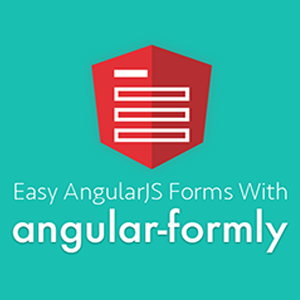<form> <div class=”form-group”> <label for=”exampleInputEmail1″>Email address</label> <input type=”email” class=”form-control” id=”exampleInputEmail1″ placeholder=”Enter email” ng-model=”vm.user.email”> </div> <div class=”form-group”> <label for=”exampleInputPassword1″>Password</label> <input type=”password” class=”form-control” id=”exampleInputPassword1″ placeholder=”Password” ng-model=”vm.user.password”> </div> <div class=”form-group”> <label for=”exampleInputFile”>File input</label> <input type=”file” id=”exampleInputFile” ng-model=”vm.user.file”> <p class=”help-block”>Example block-level help text here.</p> </div> <div class=”checkbox”> <label> <input type=”checkbox” ng-model=”vm.user.checked”> Check me out </label> </div> <button type=”submit” class=”btn btn-default” ng-click=”vm.submit(vm.user)”> Submit </button> </form>
To Only This:
<formly-form model=”vm.user” fields=”vm.userFields”> <button type=”submit” class=”btn btn-default” ng-click=”vm.submit(vm.user)”> Submit </button> </formly-form>
And use the power of Javascript to do the rest:
function YourCtrl() { var vm = this; vm.user = {}; // note, these field types will need to be // pre-defined. See the pre-built and custom templates // http://docs.angular-formly.com/v6.4.0/docs/custom-templates vm.userFields = [ { key: ’email’, type: ‘input’, templateOptions: { type: ’email’, label: ‘Email address’, placeholder: ‘Enter email’ } }, { key: ‘password’, type: ‘input’, templateOptions: { type: ‘password’, label: ‘Password’, placeholder: ‘Password’ } }, { key: ‘file’, type: ‘file’, templateOptions: { label: ‘File input’, description: ‘Example block-level help text here’, url: ‘https://example.com/upload’ } }, { key: ‘checked’, type: ‘checkbox’, templateOptions: { label: ‘Check me out’ } } ]; }
Getting Started with Formly
1. Add the following files in index.html
<!– angular and required files for angular formly –> <script src=”lib/angular-formly/api-check.min.js”></script> <!– For Validations in Angular formly using ngMessage required angular version is 1.4.7 –> <script src=”lib/angular/angular_v1_4_7.min.js”></script> <script src=”lib/angular-formly/ui-bootstrap-tpls.min.js”></script> <script src=”lib/fileInput/fileinput.min.js”></script> <script src=”lib/angular-formly/formly.min.js”></script> <script src=”lib/angular-formly/angular-formly-templates-bootstrap.min.js”></script> <script src=”lib/angular-message/angular-messages.min.js”></script> <script src=”lib/angular-formly/angular-animate.min.js”></script>
- Now add formly and formlyBootstrap as a dependency in app.js. You can also add ngAnimate and ngMessages which shows error messages at the time of validation.
// app.js (function() { ‘use strict’; angular.module(‘formlyApp’, [‘formly’, ‘formlyBootstrap’,’ngAnimate’,’ngMessages’]); })();
- Now set up angular formly form in HTML.
<body ng-app=”formlyApp” ng-controller=”MainController as vm”> <div class=”container col-md-4 col-md-offset-4″> <form novalidate> <h1>Customer Details</h1> <formly-form model=”vm.customer” fields=”vm.customerFields” form=”vm.customerForm”> <button type=”submit” class=”btn btn-primary” ng-disabled=”vm.customerForm.$invalid”> Submit</button> </formly-form> </form> </div> </body>
- Set Up the Controller
Create an array called vm.customerFields with the objects describing the fields in the form.
Key: Form field objects need a unique key which generally describes what the purpose of the field.
Type: The form types such as input, textarea, select, radio etc needs to be registered with the formlyConfig service/provider. (Already done for the Bootstrap templates)
TemplateOptions: This is an object where we further describe the properties for the field like – the kind of input, label and placeholder, whether the field is required. To add more fields in the form just add more objects into this array. This is very easy to maintain and edit anytime.
This is how the code snippet looks:
// scripts/MainController.js … function MainController(province) { var vm = this; // The model object that we reference // on the element in index.html vm.customer = {}; // An array of our form fields with configuration // and options set. We make reference to this in // the ‘fields’ attribute on the element vm.customerFields = [ { key: ‘first_name’, type: ‘input’, templateOptions: { type: ‘text’, label: ‘First Name’, placeholder: ‘Enter your first name’, required: true } }, { key: ‘last_name’, type: ‘input’, templateOptions: { type: ‘text’, label: ‘Last Name’, placeholder: ‘Enter your last name’, required: true } }, { key: ’email’, type: ‘input’, templateOptions: { type: ’email’, label: ‘Email address’, placeholder: ‘Enter email’, required: true } }, ]; } …
The form is now ready with 3 fields. You can perform custom validations for each field, disable fields, create custom fields using templates etc. (One of the best example of custom fields is
here).
You can also set a wrapper to use this field globally.
An example where we used the
ngMessage directive to show error messages for invalid inputs in a form. Using this wrapping made the whole process of displaying error messages very simple.
app.config(function (formlyConfigProvider) { formlyConfigProvider.setWrapper({ name: ‘validation’, types: [‘input’], template:'<formly-transclude></formly-transclude><div ng-messages=”fc.$error” ng-if=”form.$submitted || options.formControl.$touched” class=”error-messages”><div ng-message=”{{ ::name }}” ng-repeat=”(name, message) in ::options.validation.messages” class=”message”>{{ message(fc.$viewValue, fc.$modelValue, this)}}</div></div>’ }); })
Hopefully we were able to elaborate some of the advantages of using Angular-Formly. It has very good documentation with tons of examples. There are prebuilt templates for Bootstrap,LumX, and Vanilla HTML and WIP template libraries for angular material,Iconic and foundation. It is very easy to create custom templates and reuse them. Configuring validations is a cake walk.
if you are a newcomer to angular, you should check out the
official angular-formly website. You can get in touch with the module’s maintainer,
Kent.C.Dodds for any questions or help. He is super responsive to any queries.






